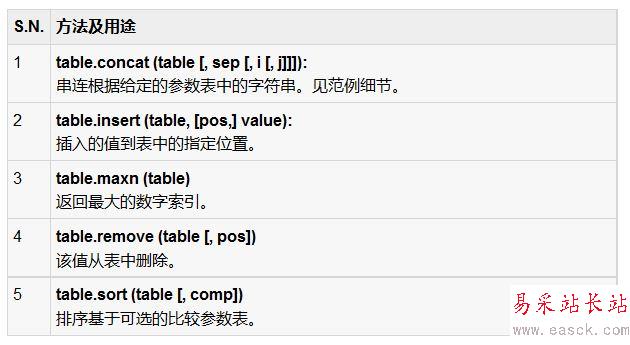表格是唯一的數據結構中Lua可以幫助我們創造出不同的類型,如數組和字典。 Lua使用關聯數組和可不僅數字,但也有不同的零字符串索引。表格都沒有固定的大小,并根據需要可以增長。
Lua采用的所有陳述,包括包裝的代表性表。當我們訪問一個方法的字符串。格式,這意味著,我們正在訪問的格式化功能的字符串封裝。
表示和用法
表稱為對象和它們既不值,也沒有變。 Lua使用構造函數表達式{}創建一個空表。它是要知道,有保存表的參考和表本身的變量之間沒有固定的關系。
代碼如下:--sample table initialization
mytable = {}
--simple table value assignment
mytable[1]= "Lua"
--removing reference
mytable = nil
-- lua garbage collection will take care of releasing memory
當我們有一個表與集合的元素,如果我們將其指定為b,a和b都指向相同的內存。沒有單獨的內存單獨分配對b。當設置為無,表將仍然可以訪問到b。當沒有引用表,然后在Lua垃圾收集需要清理過程,使這些未引用的內存再次被重用。
一個例子如下所示用于說明表的上述特征。
代碼如下:-- Simple empty table
mytable = {}
print("Type of mytable is ",type(mytable))
mytable[1]= "Lua"
mytable["wow"] = "Tutorial"
print("mytable Element at index 1 is ", mytable[1])
print("mytable Element at index wow is ", mytable["wow"])
-- alternatetable and mytable refers to same table
alternatetable = mytable
print("alternatetable Element at index 1 is ", alternatetable[1])
print("mytable Element at index wow is ", alternatetable["wow"])
alternatetable["wow"] = "I changed it"
print("mytable Element at index wow is ", mytable["wow"])
-- only variable released and and not table
alternatetable = nil
print("alternatetable is ", alternatetable)
-- mytable is still accessible
print("mytable Element at index wow is ", mytable["wow"])
mytable = nil
print("mytable is ", mytable)
當我們運行上面的程序,會得到下面的輸出
代碼如下:Type of mytable is table
mytable Element at index 1 is Lua
mytable Element at index wow is Tutorial
alternatetable Element at index 1 is Lua
mytable Element at index wow is Tutorial
mytable Element at index wow is I changed it
alternatetable is nil
mytable Element at index wow is I changed it
mytable is nil
表操作
在對表操作內置函數和它們被列于下表中。

讓我們看看上面的函數一些例子。
表串聯
我們可以使用concat函數來連接,如下所示的兩個表。
代碼如下:fruits = {"banana","orange","apple"}
新聞熱點
疑難解答